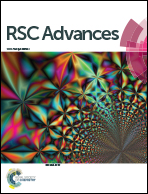Engineering plasmonic Ag/AgCl–polydopamine–carbon nitride composites for enhanced photocatalytic activity based on mussel chemistry†
Abstract
The interfacial interaction plays an important role in composites, by affecting the physical and chemical properties of those composites. Herein, we present a simple and versatile approach for the construction of plasmonic Ag/AgCl–polydopamine–CN (SPCN) composites with enhanced photocatalytic properties by mussel chemistry. Dopamine hydrochloride acts as both the reactant and the reducing agent, and the product polydopamine (PDA) serves as the adhesive layer and the electron transfer bridge. The photocatalytic degradation of rhodamine B (RhB) shows that the SPCN50 composite displays excellent photocatalytic activity. A radical trapping experiment indicates that holes are the main oxidative species in the photocatalytic process, and a possible photocatalytic mechanism is proposed. All the results prove that PDA indeed improves the separation efficiency of photogenerated carriers and the photocatalytic activity. This work may provide a green, universal method to synthesize plasmonic photocatalytic composites with high catalytic performance.


 Please wait while we load your content...
Please wait while we load your content...